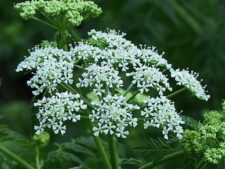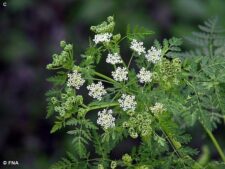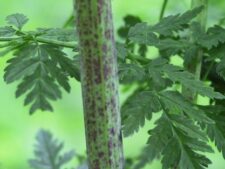
POISON HEMLOCK
Conium maculatum
PARSLEY FAMILY (Apiaceae)
 Identification
Identification
- Flowering time - May, June, July
- Uncommon on disturbed ground, particularly roadsides
- Flat topped flower clusters (compound umbels) composed of 10-15 smaller clusters (umbellets)
- Divided, triangular fern like leaves
- Stout stems with purple blotches
This very poisonous naturalized biennial was introduced from Eurasia. The first year a rosette of carrot-like leaves appears. The second year a stem shoots up rapidly, starting early in spring, eventually reaching a height of 10 feet or more. The stout grooved stems have purple blotches (D). The large, triangular leaves are repeatedly divided (C,D). Shallow slightly dome-shaped clusters (compound umbels) each composed of 10-15 smaller flower clusters (umbellets) bear many small white flowers with 5 petals (B,C).
Found commonly along roads, railroad tracks and waste ground, flowering from May to July. In Fontenelle Forest it is common along Camp Gifford Road, west of the railroad tracks. It has not yet been seen, but is possible at Neale Woods.
All parts of this plant are highly poisonous. A potion derived from this plant was used to put Socrates and others to death in ancient Greece. Also known as Spotted Parsley and Poison Parsley
The content of NatureSearch is provided by dedicated volunteer Naturalists of Fontenelle Forest who strive to provide the most accurate information available. Contributors of the images retain their copyrights. The point of contact for this page is: Roland Barth.



